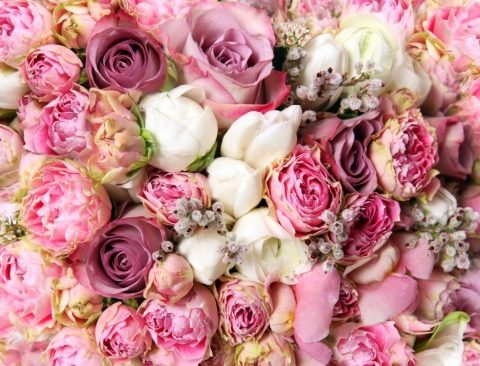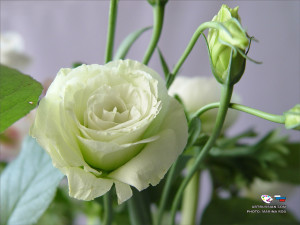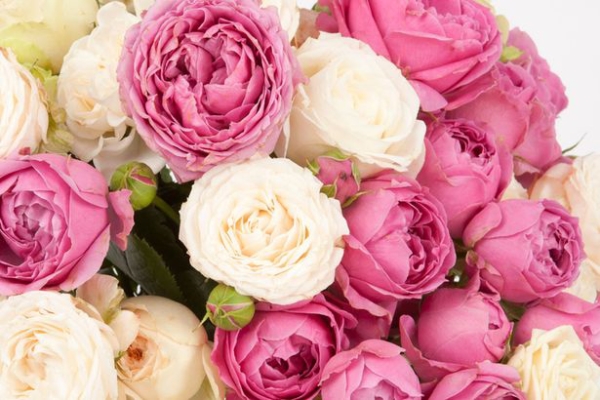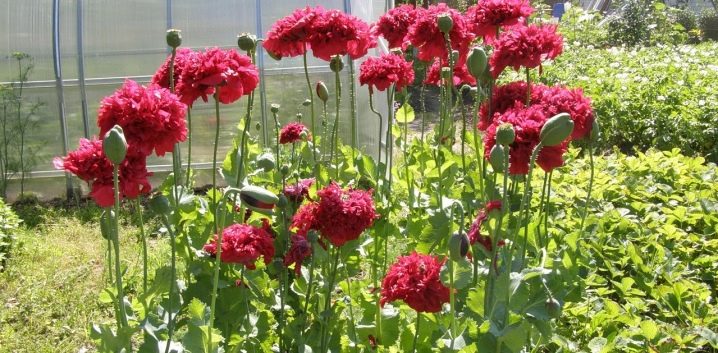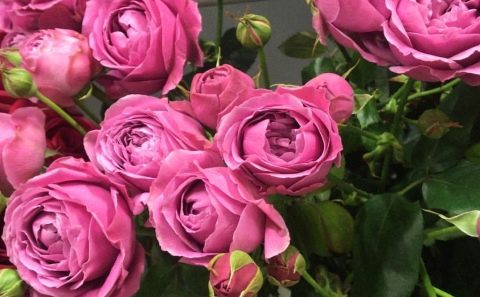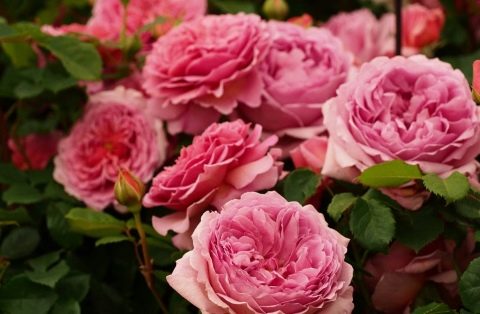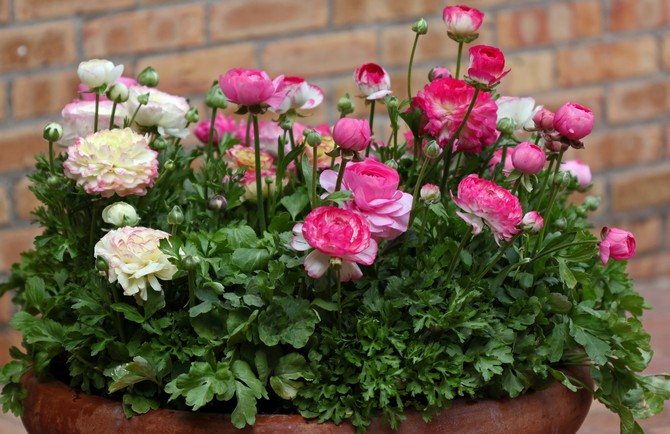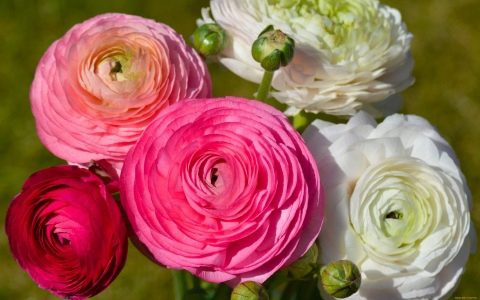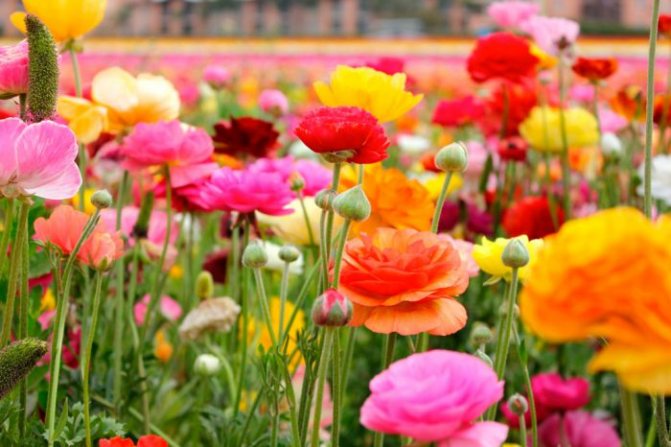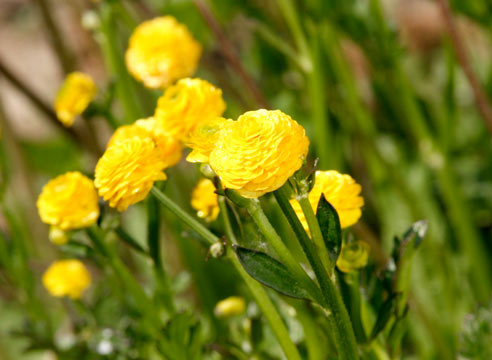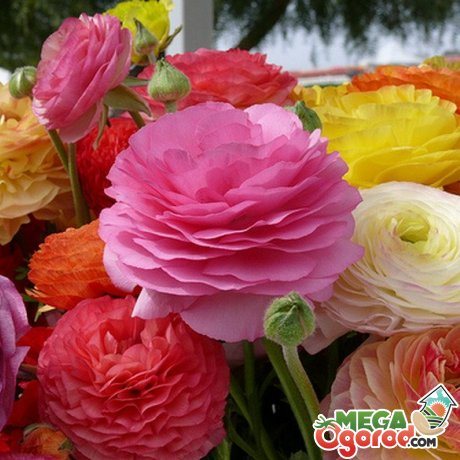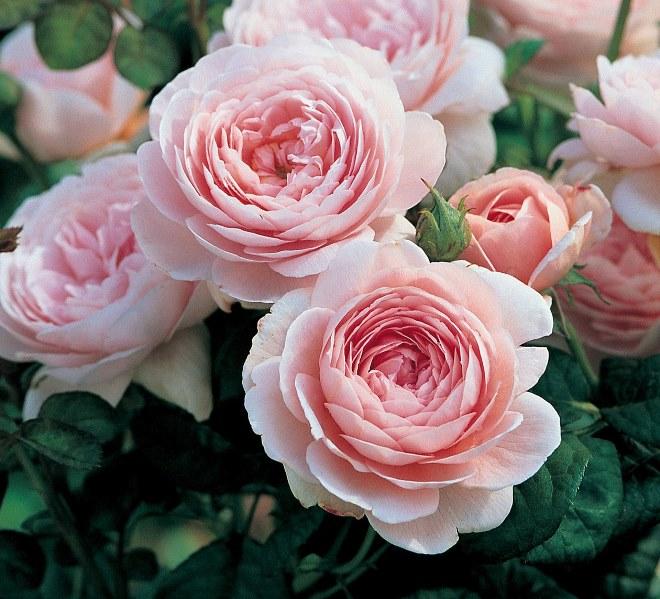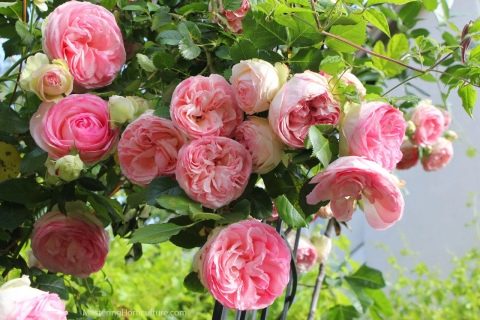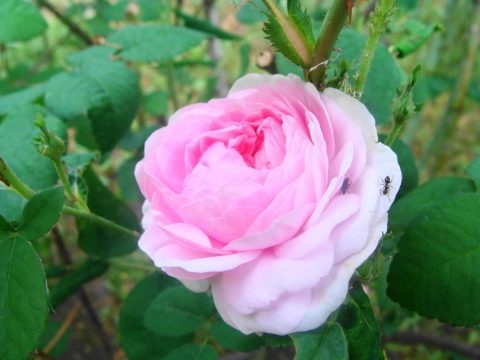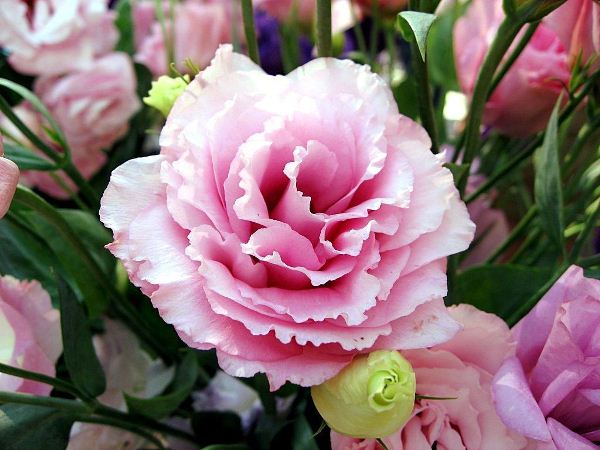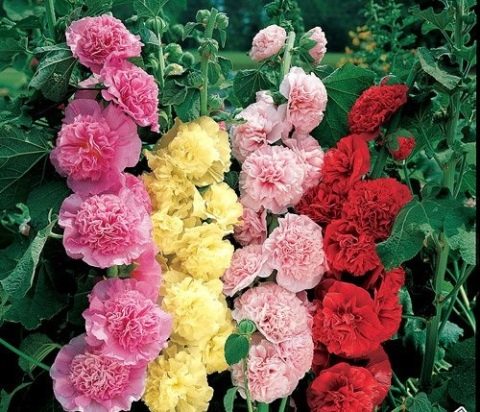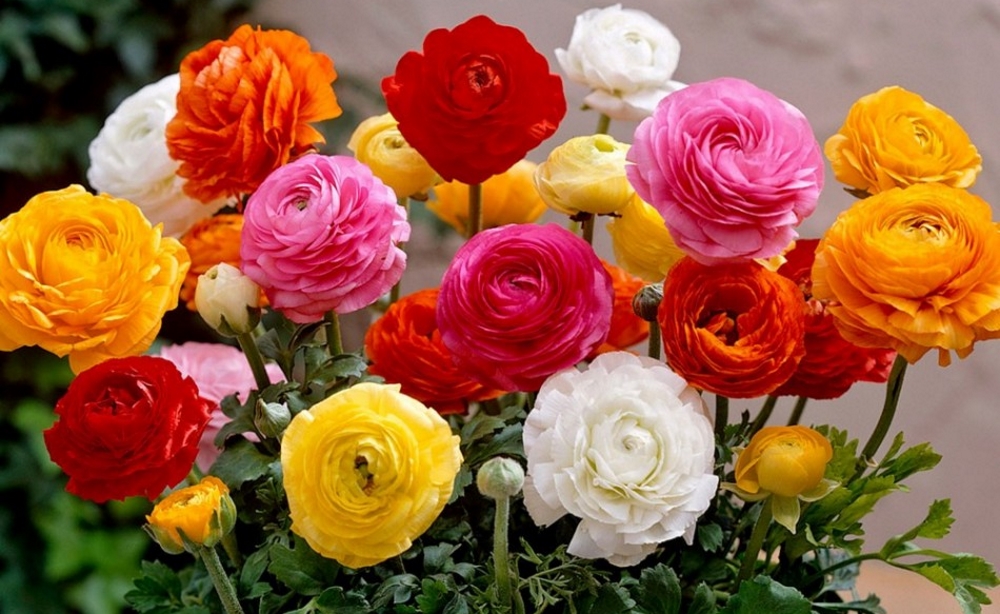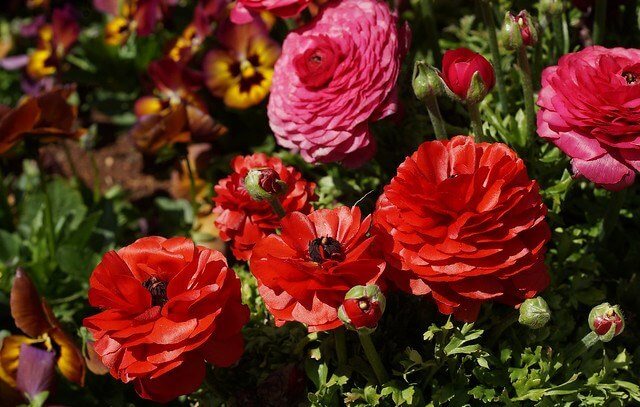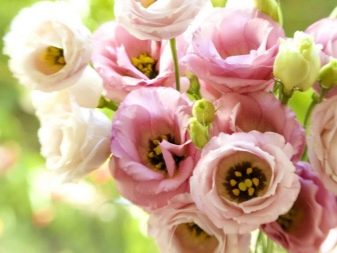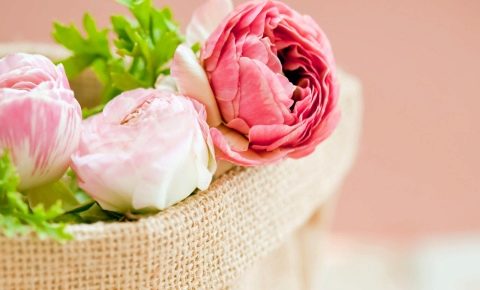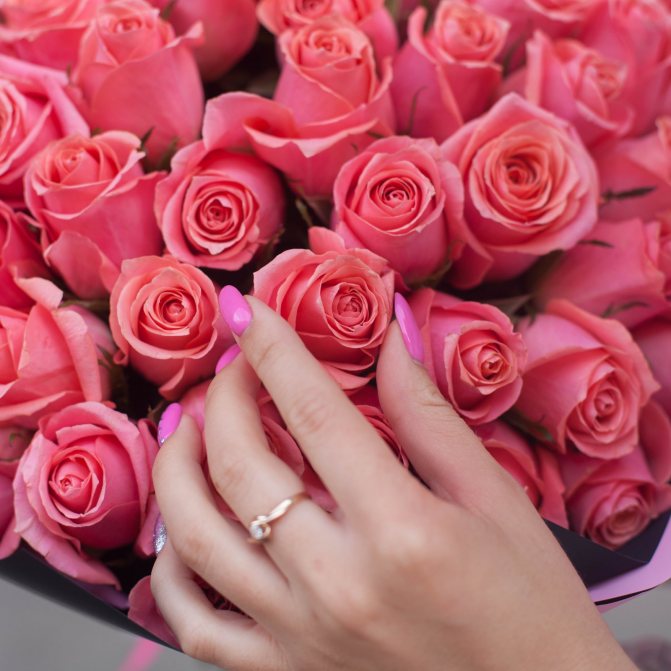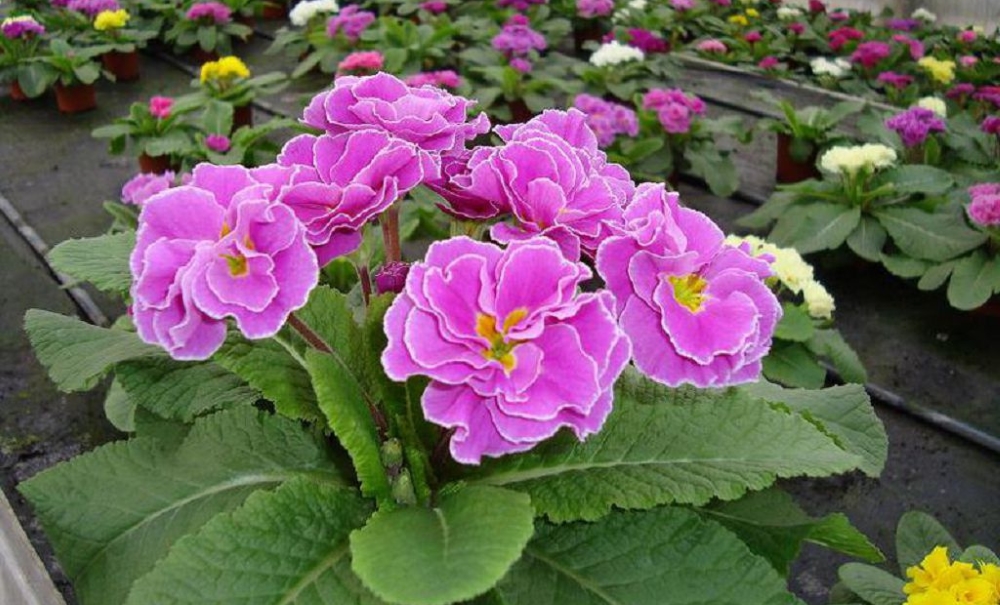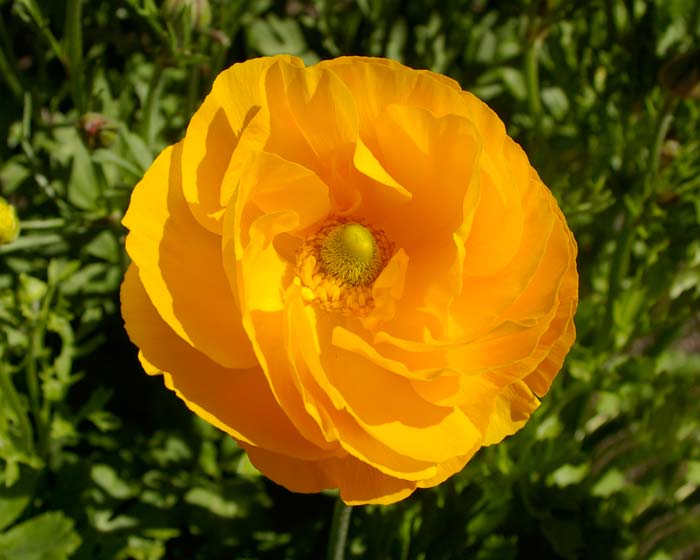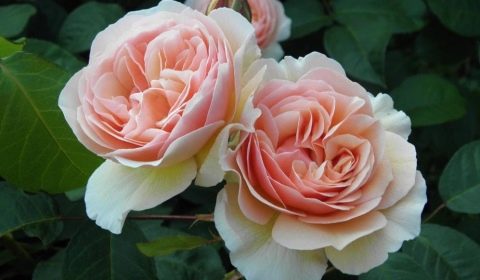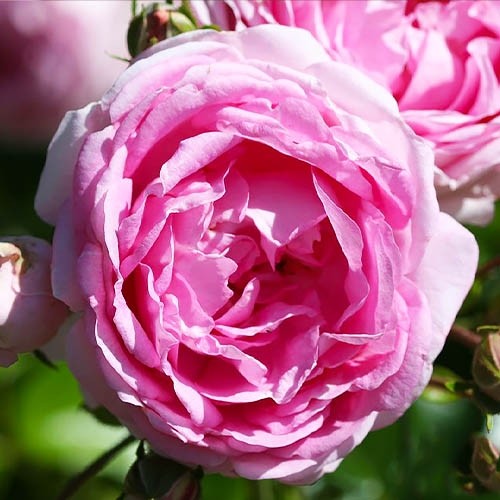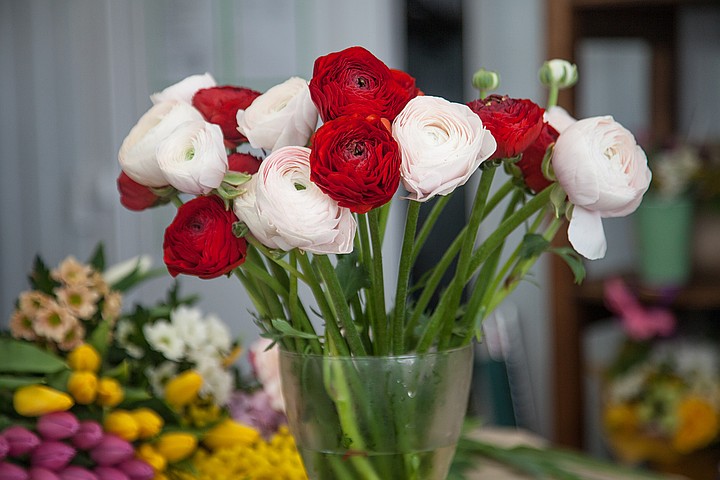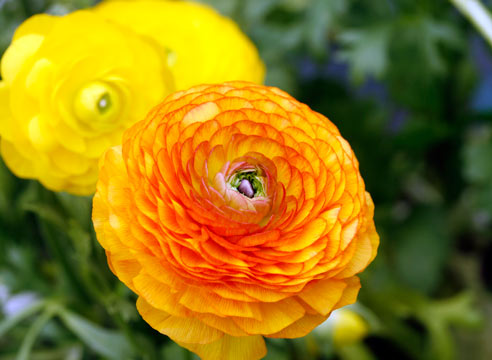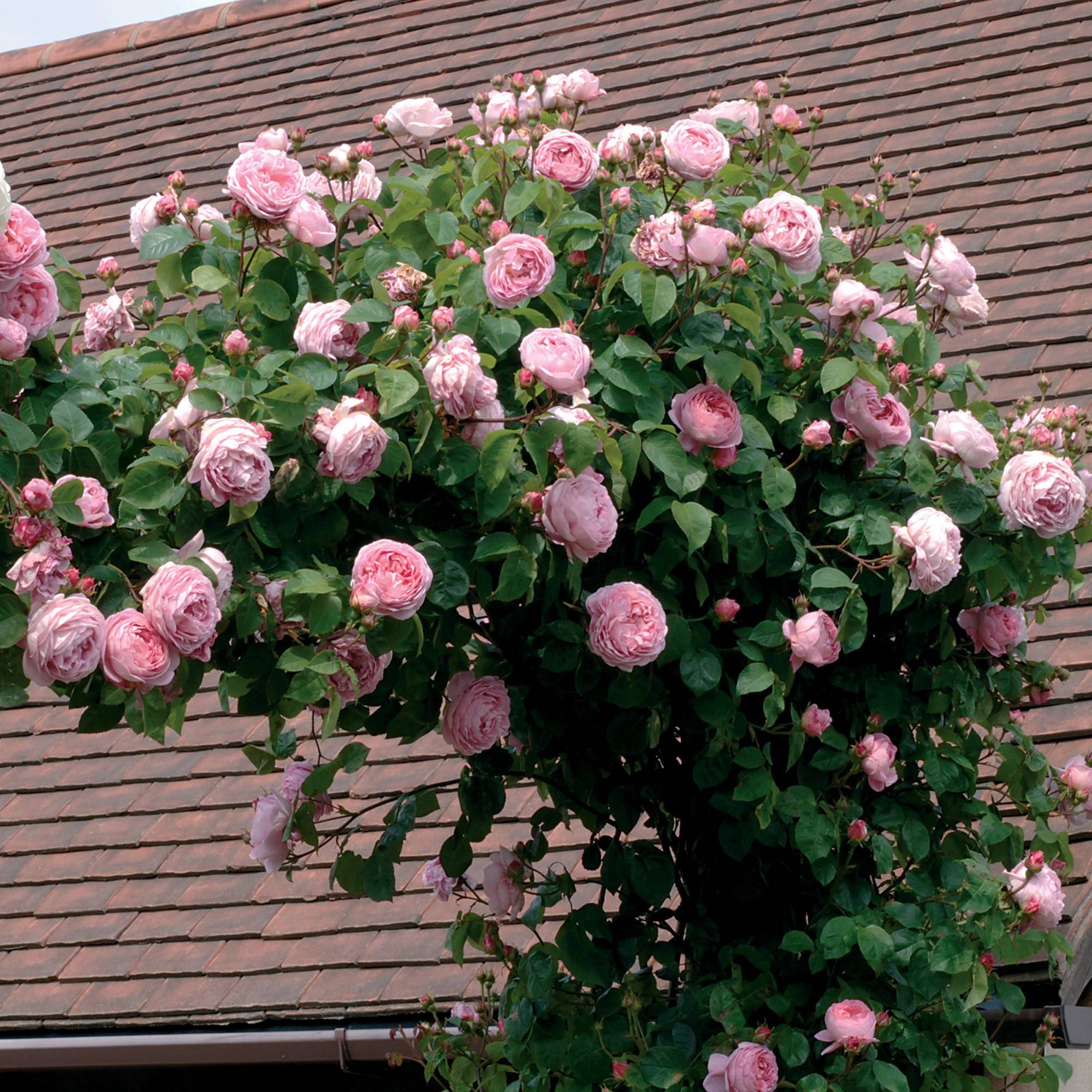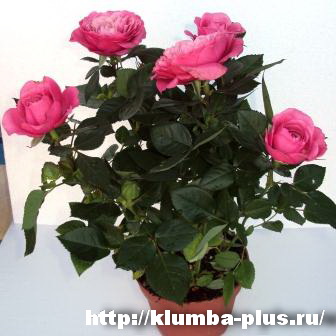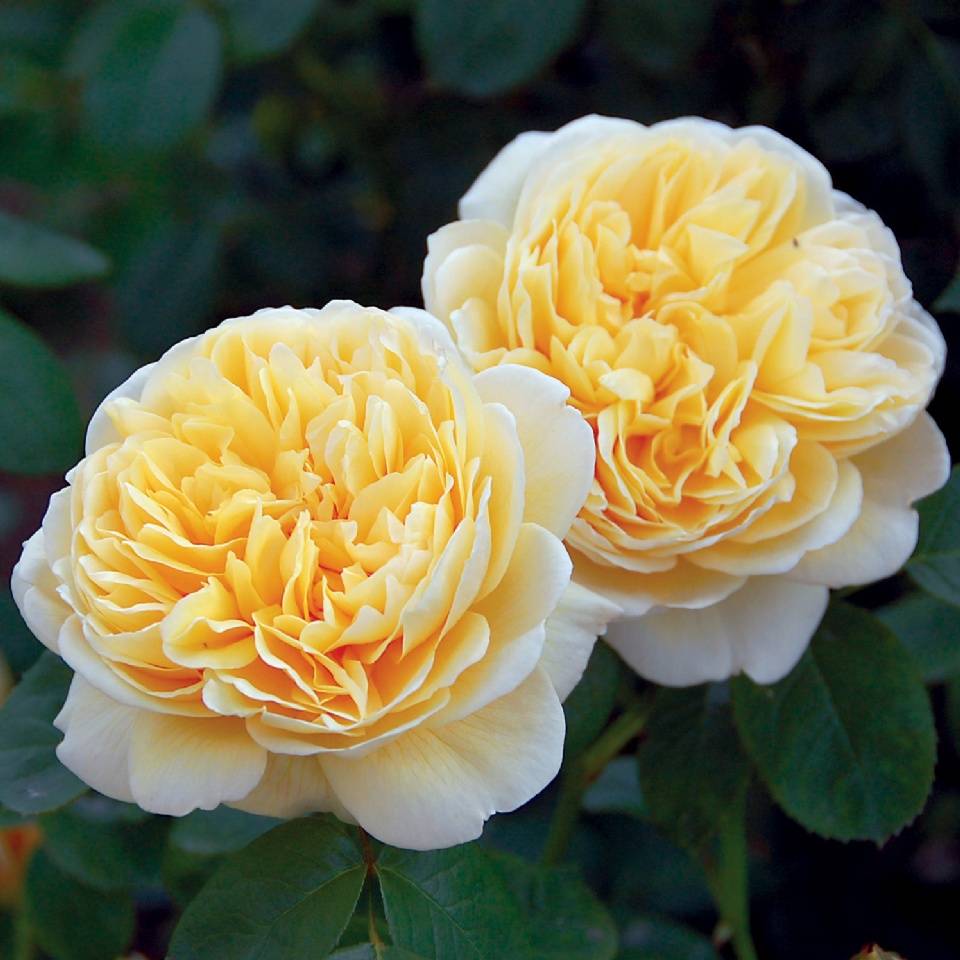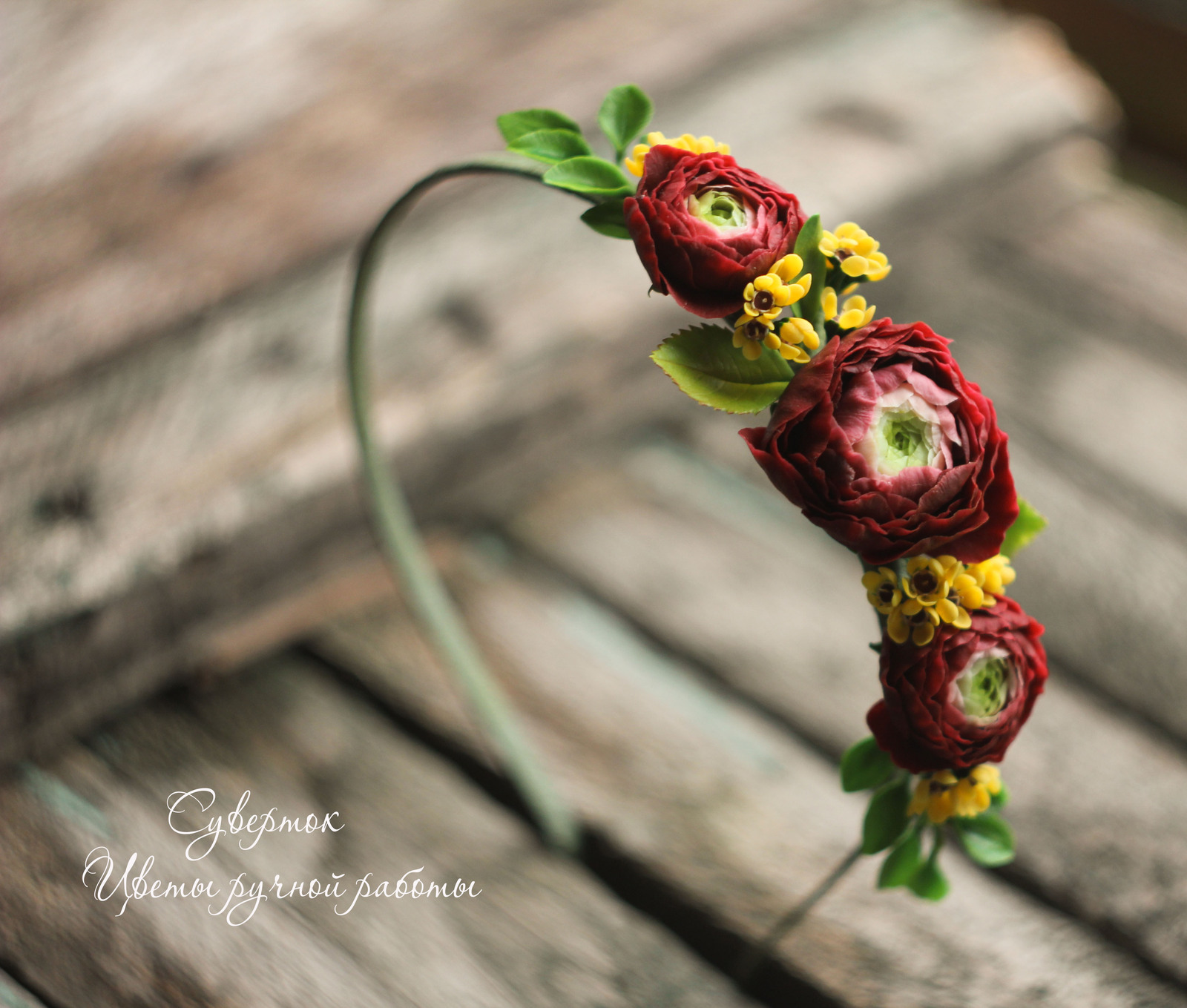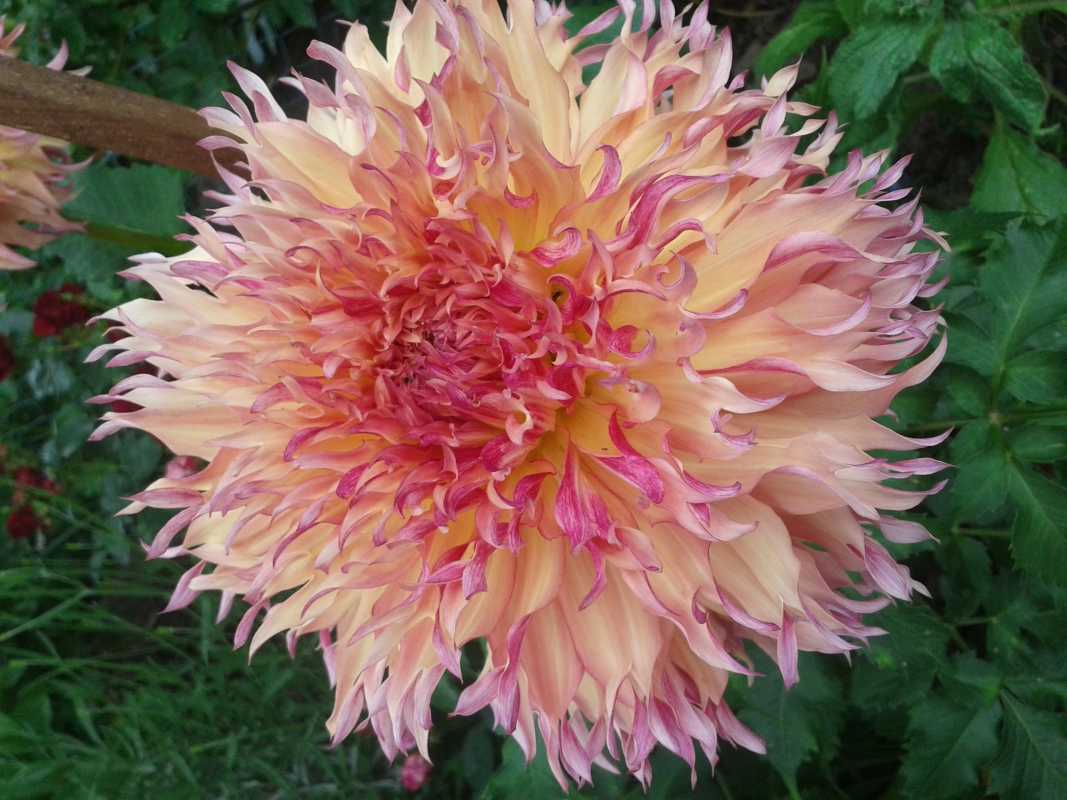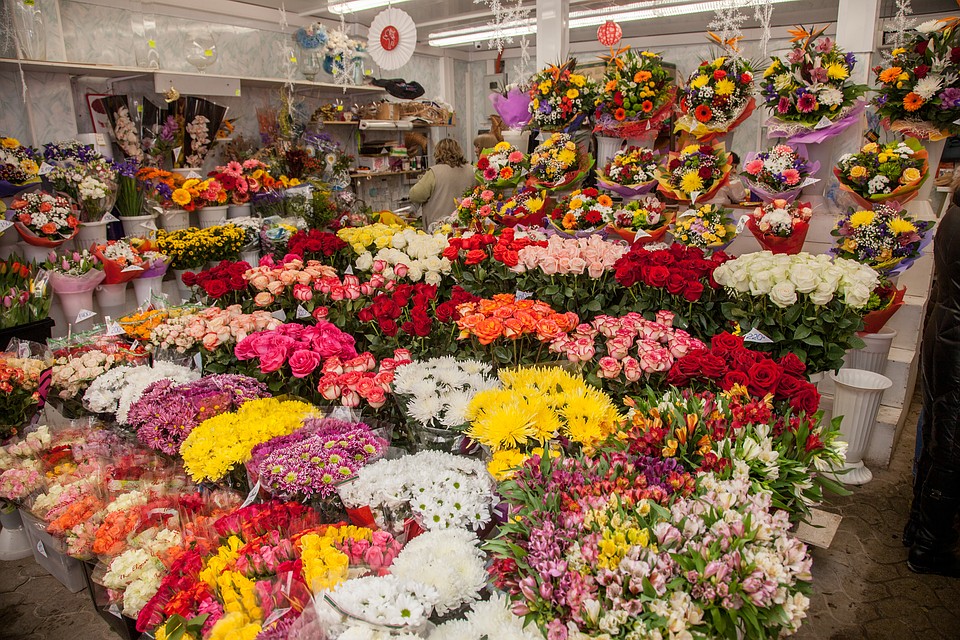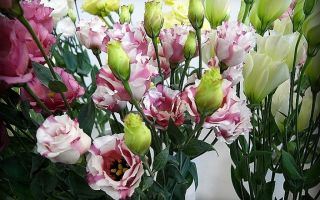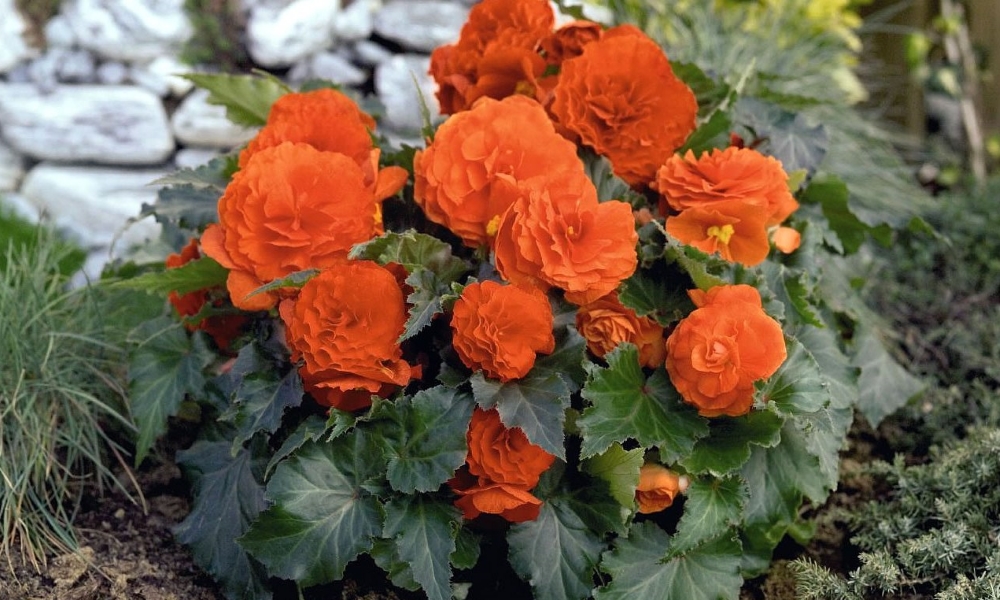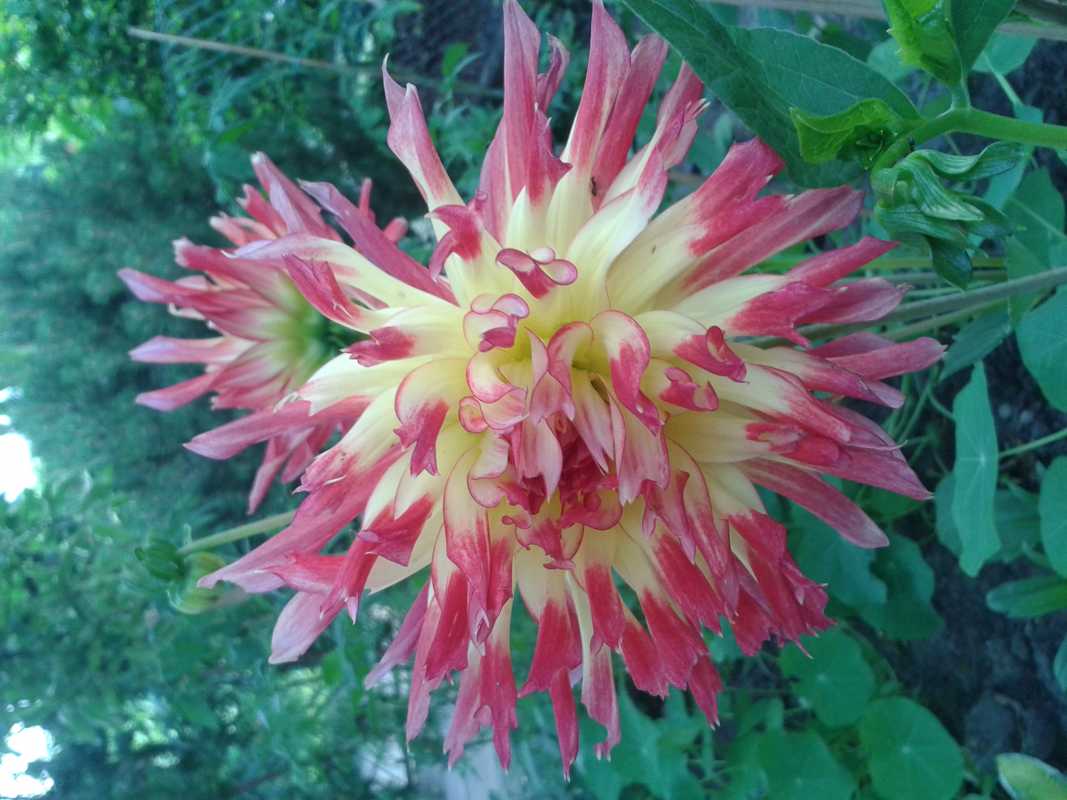Tulips that look like peonies
How many petals do spring primroses have - 5-7? No, peony varieties have more than 20 of them! Imagine how beautiful the bouquet looks when each the bud reveals several dozen colored petals
The first double tulips appeared more than 4 centuries ago, but still less than 10% of the market is devoted to these flowers. The idea of the tulip as a modest, non-fluffy plant is too deeply rooted. We urge our readers to break stereotypes and enjoy peony tulips before the season of their large-doubled counterparts has yet arrived.
Now you know, what can be used to replace peonies before their season arrives.
It turns out that the choice is very large, and every month you can please your beloved with voluminous and bright compositions.
The season of peonies has begun
Discounts up to 40%!
-Categories
- Animals (299)
- lapotuli_krasotuli (175)
- animals_planets (62)
- wild paws (40)
- bird_world (12)
- world_ under water (10)
- Army (28)
- useful, necessary (4)
- astrology (22)
- knowledge (7)
- esotericism (12)
- Home (393)
- knit (58)
- holidays (6)
- on__ windowsill (41)
- vegetable garden, flowerbed (59)
- own __ hands (111)
- home tips (68)
- comfort (29)
- we sew_ (21)
- health (617)
- masks (87)
- folk recipes (296)
- spices (11)
- tips (189)
- Interesting: (952)
- cities__ (81)
- story_2 (13)
- interesting__ (199)
- history 41-45 (17)
- history_ (119)
- stones__ (17)
- legends, myths (28)
- invisible__ (26)
- informative_ (142)
- parable (20)
- miscellaneous_ (97)
- mystery__ (34)
- phenomena, riddles (72)
- photo story (77)
- quotes, wisdom, aphorisms (30)
- Internet (327)
- internet_advice (97)
- internet_litcher (51)
- programs _schemes (103)
- lessons_ lyre (76)
- Cinema Hall (147)
- documentary (31)
- melodrama, TV series (26)
- cartoons (2)
- __ movie history (11)
- story of __ actors (19)
- movies (58)
- books (44)
- Cooking (590)
- second (89)
- bake (181)
- blank (99)
- liqueurs (24)
- recipe (140)
- salad (18)
- kitchen tip (39)
- Music sounds (186)
- clips (11)
- history (7)
- ringtones (14)
- songs (154)
- Cognition (670)
- for knowledge (129)
- for tips (42)
- for_soul (44)
- for__women (29)
- for__men (5)
- for__family (58)
- icons (17)
- prayers__ (39)
- verse (307)
- Photos (496)
- paintings_ (41)
- amazing_universe (15)
- amazing_underwater (41)
- amazing_near (199)
- _pictures (21)
- _fun (93)
- _porcelain (24)
- _humor_jokes (62)
Description
Today, quite a few peony-like flowers are grown with different colors and texture of petals. Peony roses are gaining more and more popularity, although they appeared relatively recently. The bushes differ in their beautiful decorative appearance: they look like roses, and in structure and shape, which can be double or semi-double, are very similar to peonies.

The choice of varieties is quite wide, the color of the buds can vary from pale pink to purple or orange. There are also variegated varieties. Flowers have a delicate, pleasant aroma. Florists pay tribute to this species for the minimum demanding care and excellent resistance to disease.
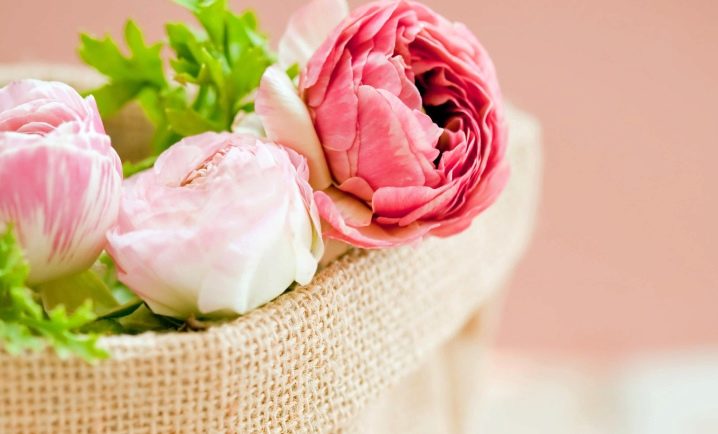


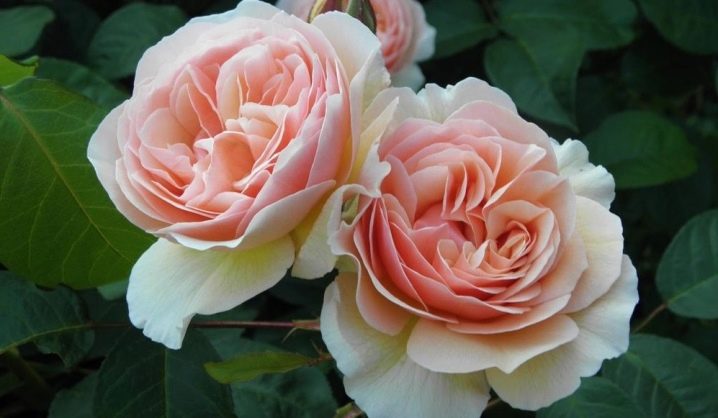
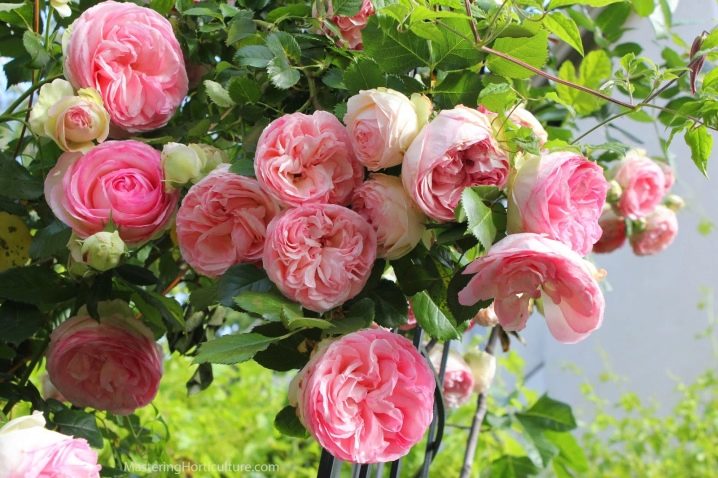
Terry mallow is a tall perennial with a large number of fluffy peony flowers with elongated petals of the most varied tones: white, pink, yellow, different shades of red and purple.
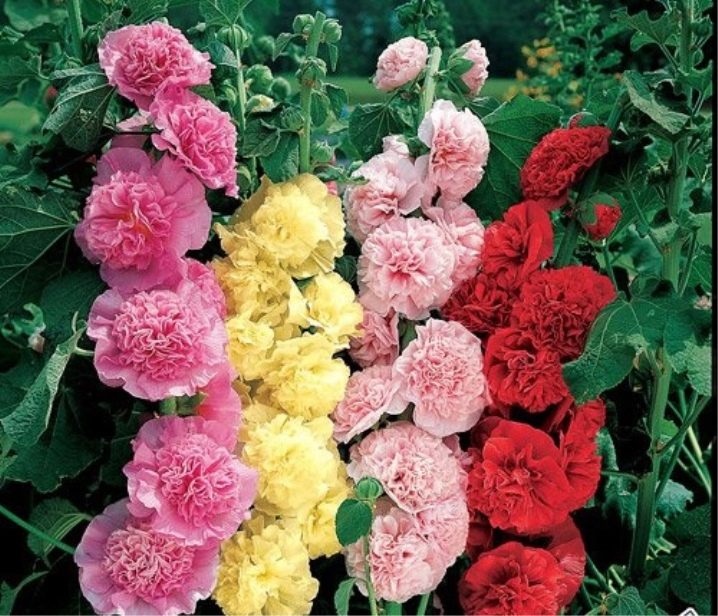
Terry begonia has inflorescences in the form of a volumetric bowl with a diameter of about 15 cm, which rests on a squat pedicel. Multilayer buds bloom in white, pink, scarlet, amber or yellow.
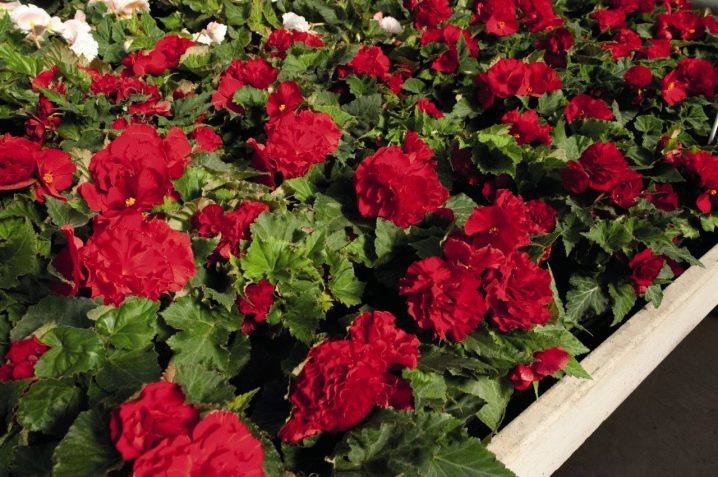
The pion-shaped aster is the most beautiful representative of its family. It grows up to half a meter, spherical flowers with a diameter of about 10 cm, painted in different colors. The flower is appreciated for the duration of flowering and immunity to diseases.
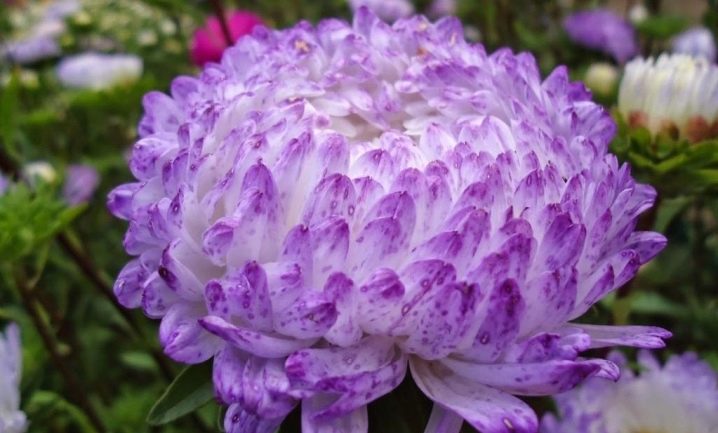
Ranunculus or Asiatic buttercup is a perennial plant that prefers damp, swampy areas for growth. Stems can grow up to 80 cm, peony buds have different color shades. Depending on the variety, they can be snow-white, pink, scarlet, yellowish, cherry, purple, even a light green tone.They also differ in shape, there are varieties with terry, semi-double or thick double bowls. Due to its unusually elegant appearance, the flower is often included in bridal bouquets.
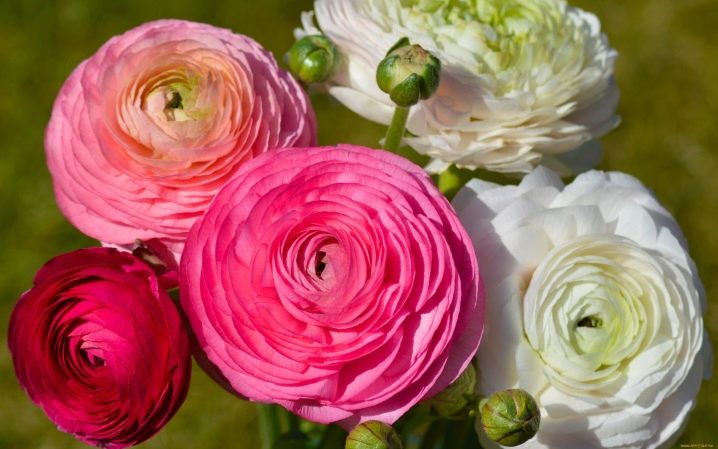
Terry tulips have a somewhat peculiar glass. It can be both in the form of an open bowl, and a somewhat narrowed, bell-shaped form with a large number of petals. Hybrids have a variety of colors, not only the usual pastel or reddish shades, but also blue, blue, purple and even black.
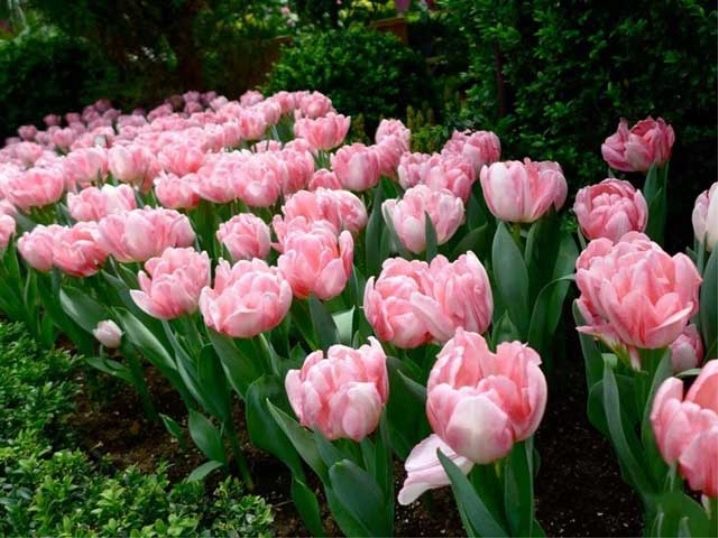
Among the most popular varieties of double tulips, we note:
"Abba";
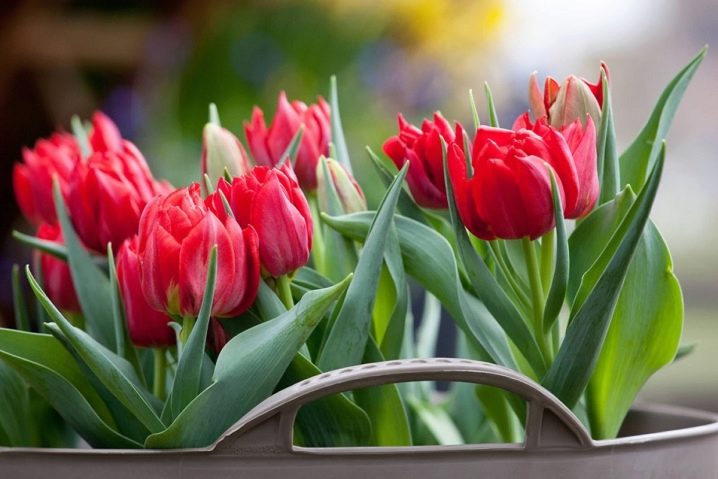
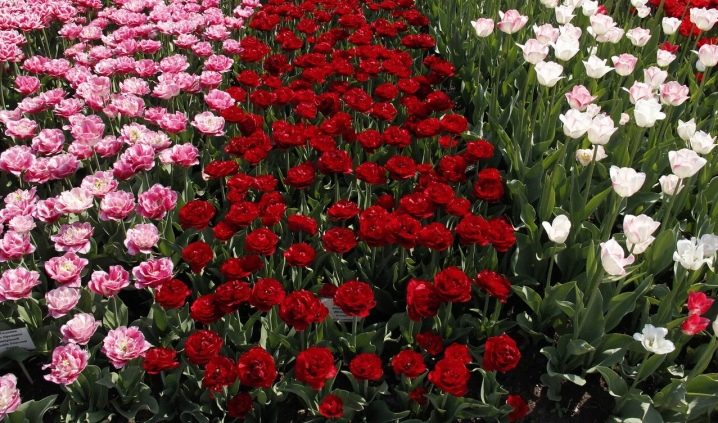

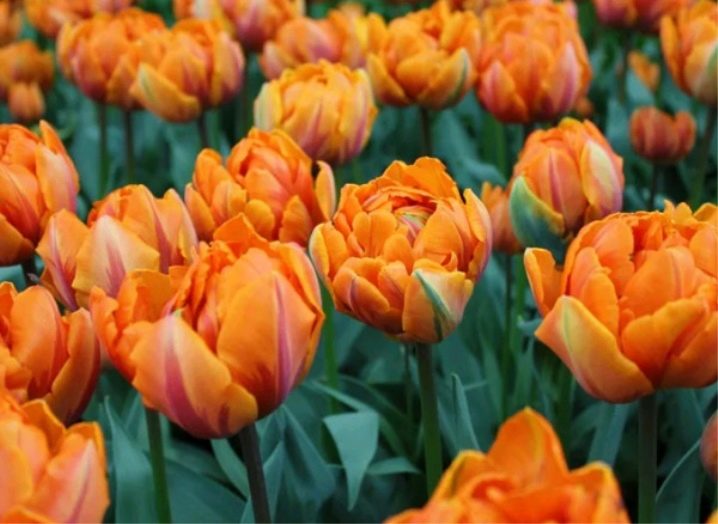
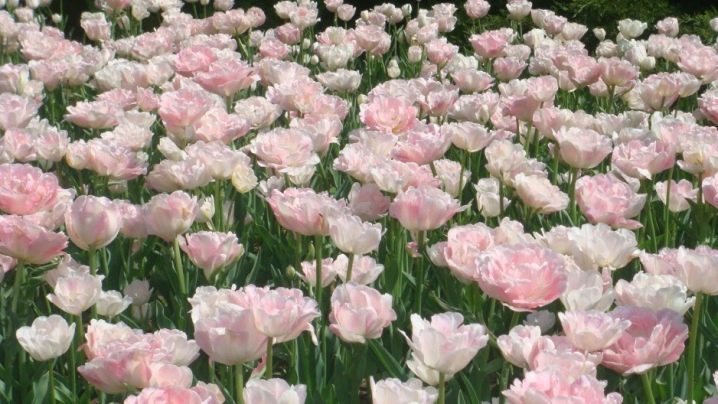
As a result of the labors of breeders, varieties with an unusual combined color of buds have also been bred. Camellia with its flowers is also similar to peonies. Since it blooms in winter, it is grown as an indoor flower. Terry buds of white, pink or scarlet color. The flowering period is long, it can last up to 3 months. There are varieties with a variegated color.
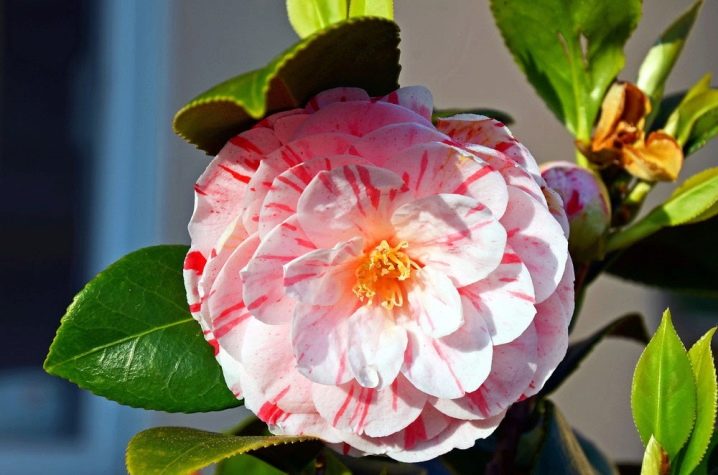
Eustoma or, as it is also called, the Irish rose is a perennial representative of the Gentian family. She belongs to very thermophilic cultures, so she is an extremely rare guest here. In the natural environment, the plant can reach a height of 1 meter, the stems are rather branched, each forms up to 35 double buds, similar to small peonies, although the buds are bell-shaped. Flowers have a variety of shades, there are also blue. There are monochromatic, variegated or edged inflorescences. Cut buds can stay fresh for up to 2 weeks. The flowering period is quite long, starting in June and ending in September.
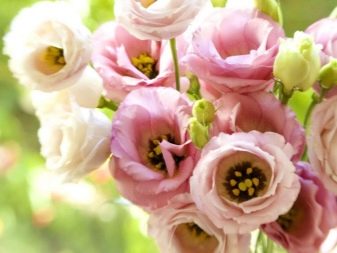

Carnation also has peony varieties. Double flowers are formed singly and in small groups. Flowering can last 3-4 months. The most famous peony-like variety is the Shabo carnation.
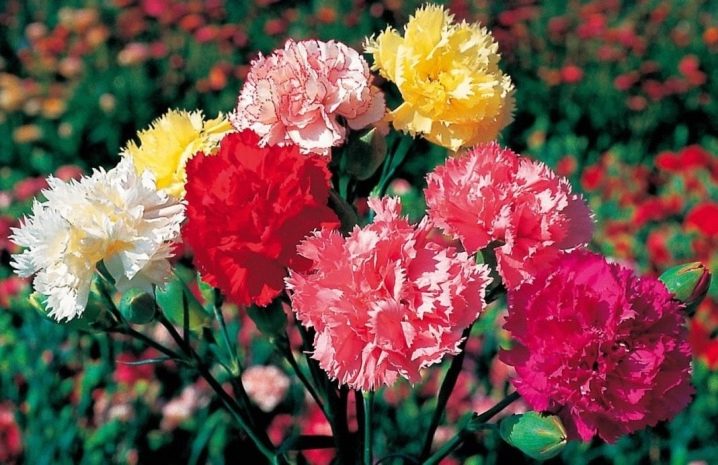
Daffodils, similar to peonies, can have only one double crown or a whole flower. Peony-like varieties of daffodil:
"Flower bed";
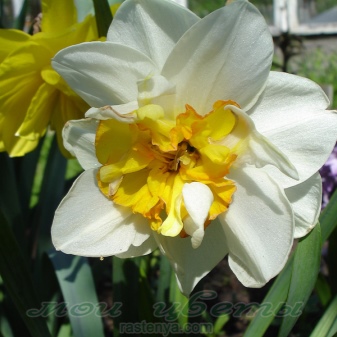
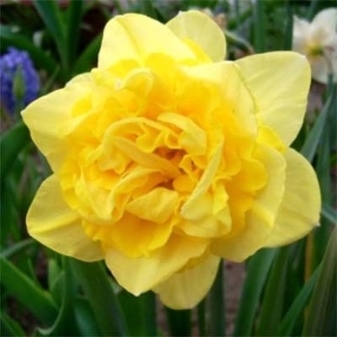
Chrysanthemum large-flowered, or rather, only some of its varieties, are characterized by buds similar to peonies. The flowers reach quite significant sizes, they are used mainly for cutting.
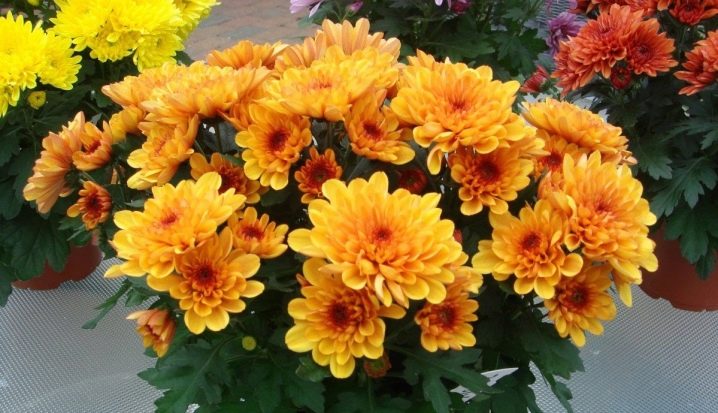
Peony poppy was specially bred by selection to imitate a peony.
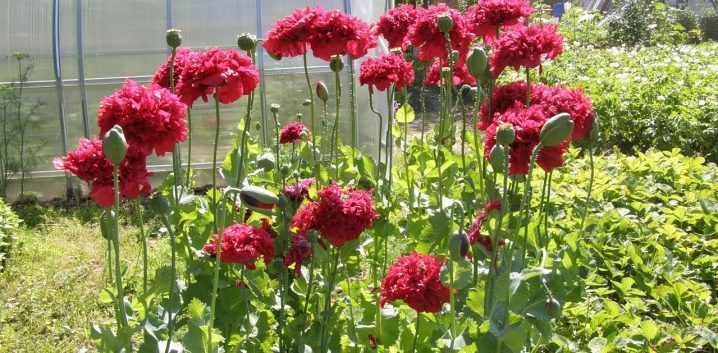
Features of agricultural technology of Japanese peonies
If we take into account the few requirements of culture for agricultural technology, the Japanese peony becomes a completely problem-free plant and "thanks" the gardener for the duration and abundance of flowering:
- Lighting. Direct sunlight, unlike many "congeners", tolerate well, the petals do not fade and do not crumble. Light partial shade is also suitable. In dense shade, they practically do not bloom, the stems become thinner and strongly elongated.
- Location. Japanese peonies have nothing against the "neighborhood" with trees, shrubs. Dense, abundant plantings in the selected area do not interfere with their normal development, if the plants have enough light.
- Reproduction. It is possible to divide the bushes of the Japanese peony within 4 years after planting in the ground. Other species will have to wait 5–6 years.
- Watering. "Japanese" are watered much more often than "relatives" - at least twice a week, 7–8 liters per adult plant. Intensive watering is a prerequisite for abundant flowering. Ensure good drainage when planting to prevent stagnant water. Even with an excess of moisture, the gray rot characteristic of peonies rarely develops.
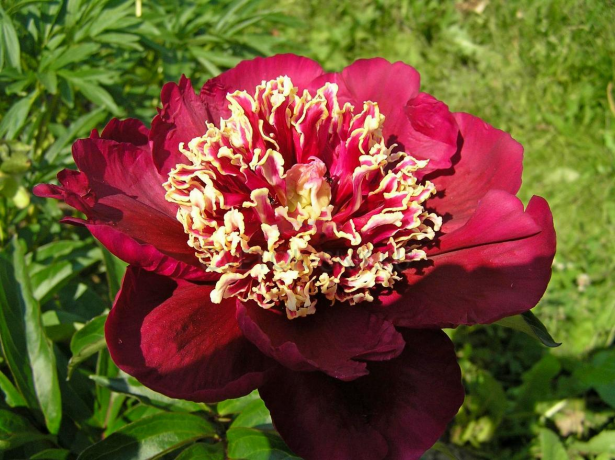
The beauty of Japanese peonies does not suffer in any way when direct sunlight hits the flowers.
At first glance, the Japanese peony does not seem as bright and catchy as its "relatives", but it is distinguished by its refined elegance. Even novice gardeners can take care of it; problems with the plant are extremely rare. This variety of peony is steadily gaining popularity, breeders are paying more and more attention to it, who continue to develop new unusual varieties.
Description of the flower
The thin-leaved peony is famous for its unusual beauty and stunning aroma. The stem can reach a length of 50-60 cm. A distinctive feature of the plant is its leaves - they are narrow, feathery, about 2 mm wide.

What is the fine-leaved peony (Paeonia tenuifolia)
Peonies are perennials, they begin to bloom only for 4-5 years. The buds bloom in the spring, in April-May. The flowers are bright red, large, outwardly reminiscent of poppies. Each has 6-8 petals, in the middle you can see crimson stamens with yellow anthers.
For your information! By the end of summer, a fruit is formed - a polysperm with black shiny seeds.

Flower appearance: petals, stamens, leaves
Other names
Translated from English, the name of the flower is "fern-leaved peony". The Latin name is Paeonia Tenuifolia. The people often call him a crow, an azure flower. Also, the thin-leaved peony is sometimes referred to in the literature as a narrow-leaved, holly, small-leaved or wild peony.
Advantages and disadvantages of the variety
The narrow-leaved peony is characterized by frost resistance and relative unpretentiousness to weather conditions. Prefers fertile non-acidic soils, poorly tolerates excess moisture. Peonies do not take root well on swampy and nitrogen-rich areas.
The buds of this plant variety begin to open at the same time, which looks very beautiful. The decorative properties of the flower are enhanced by unusual feathery leaves resembling a fern.
For your information! Peonies are famous for their medicinal properties, thanks to which infusions from different parts of the plant are actively used in folk medicine. In addition, the flower is an excellent honey plant.
Use in landscape design
Gardeners appreciate the plant for its unpretentiousness and unusual beauty. Moreover, the flower belongs to perennials, therefore it will serve as a decoration of the site for several decades. The bushes are decorative from early spring to late autumn, or, as they say, "from snow to snow." Plants fit perfectly into the landscape design of almost any site, not only lush red buds look great, but also leaves and even fruits.
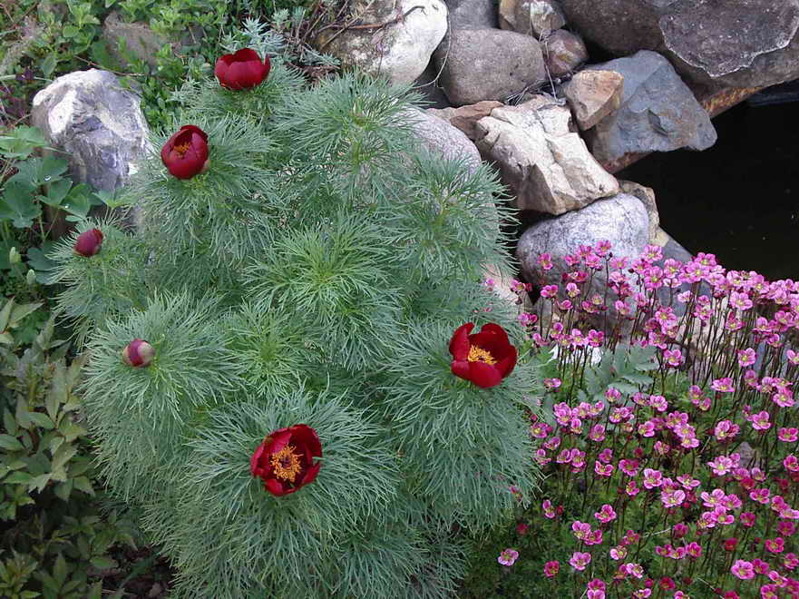
The use of peony in landscape design
Peonies get along well with other plants; bushes can be alternated with plantings of other perennials, for example, tulips. Often they are planted around the perimeter of the lawn, and they also look good against the background of conifers.
Unconventional choice
There are even more exotic options. For example, an eustoma has a flower that looks like a peony, but the shape of the bud is somewhat different - in the form of a bell, and it is much smaller in size. In a bouquet, it looks gentle and romantic. Several flowers can be located on the stem, which stand in a vase for quite a long time - up to 2 weeks. Fully blossoming, eustoma is very similar to small peonies. Its bloom begins in June and continues until early autumn.
The peony terry poppy is specially bred to imitate a peony. Unlike the field relative, it has a lot of delicate thin petals.
White terry carnations can also play this role. By themselves, they are too small, but several buds connected to each other give a flower that looks like a peony.
They are not similar in the shape of the petals, but some varieties of chrysanthemums are in no way inferior in splendor and volume. They begin to bloom at the end of summer and, before the first frost, delight us with their beauty. A peony-like flower can be found in Antonov, Shamrock, Regina White, White Korean.
A lush bud can also be found among camellias. There are even special varieties similar to peonies.
Dahlias also have subspecies with lush double inflorescences, rounded petals and pale pink color.
Surprisingly: Husbands want their wives to do these 17 things more often. If you want your relationship to be happier, you should do the things on this simple list more often.
10 adorable star children who look completely different today Time flies, and one day little celebrities become adults who are no longer recognizable. Pretty boys and girls turn into s.
How to look younger: the best haircuts for those over 30, 40, 50, 60 Girls in their 20s do not worry about the shape and length of their hairstyles. It seems that youth is created for experiments on appearance and daring curls. However, already the last.
11 Weird Signs That Indicate You Are Good in Bed Do you also want to believe that you are giving your romantic partner pleasure in bed? At least you don't want to blush and apologize.
What does the shape of your nose say about your personality? Many experts believe that looking at the nose can tell a lot about a person's personality.
Therefore, when you first meet, pay attention to the nose of the unfamiliar
What is it like to be a virgin at 30? What is, interestingly, women who did not have sex until almost middle age.
Peony is a noble perennial plant. It is loved by many gardeners due to its low exactingness.
Varieties of Japanese and anemone-shaped herbaceous peonies (with photo)
Japanese form. The name corresponds to its historical origin: the first varieties of milk-flowered peonies with such a flower shape were exported from Japan to Europe and under this name spread to the countries of the Western world. The Japanese-shaped peony flower has a corolla of outer petals and a center filled with staminodes. Staminodes are originally stamens, transformed into very narrow and elongated reed petals. They still retain the original shape and color of the stamens to a certain extent. The geometric shape of the staminodes of Japanese herbaceous peonies is complex and diverse: there are corrugated (wavy) surfaces, jagged edges, bends and fractures in height.
Most varieties of Japanese peonies with white and light pink corollas, staminodes are yellow in color. Flowers with dark pink and red corollas usually have a complex coloration of staminodes: most of them have colors close to the corolla, and the edges and tips retain yellow colors - a memory of stamens.
The pistils are usually normally developed and capable of setting seeds. Multicolor with pronounced contrast, complex and refined form of staminodes, grace and perfection give Japanese flowers an unusual originality and charm.
Peonies of varieties have a Japanese flower shape:

Barrington Bell and Gay Paris
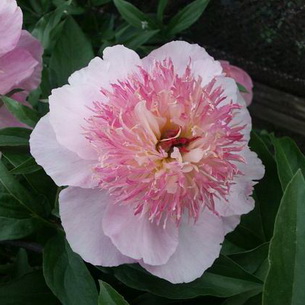
Dream Mist and Pearl Scatter

Golden Fleece and Cora Stubs

Kukeni Jishi and Lotus Queen

Momino Serdechko and Mikhail Akimov
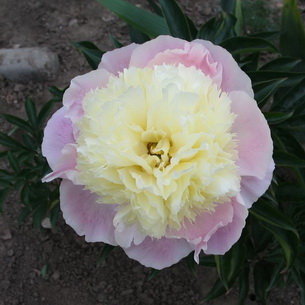
Neon and Touch of Class
These photos show various varieties of Japanese peonies:
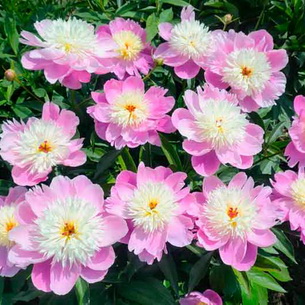
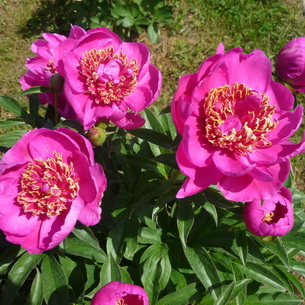
Anemonic form. The flower has a corolla of one or two rows of outer petals, like the varieties with simple and Japanese forms. The stamens are transformed into petals - petals, shortened and much smaller than the corolla petals. Petalodia are much wider and larger than staminodes in Japanese flowers. In shape, they are much more reminiscent of corolla petals, but more often they retain to some extent the yellow color from the stamens, although not in all varieties.
Anemone flowers of peonies, light and graceful, very decorative. Nevertheless, they did not have a wide distribution for quite a long time. Interest in them has grown only recently. In a number of publications in our country and abroad, in most catalogs, varieties with an anemone shape do not distinguish a separate group, but are classified as Japanese or terry, depending on the degree of development and color of petalodia.
Representatives of anemone varieties of peonies:
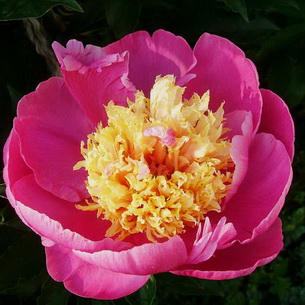
Ama No Sode and Velma Atkinson
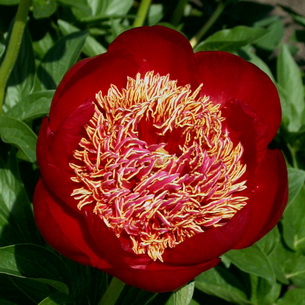
Kapen Gray and Coral Queen

Kuril Islands and White Cap
Care
There are quite a few different flowers that look very similar to peonies, but are not. You need to be able to distinguish between them in order to decide what kind of care and necessary conditions to create, as they may differ.Peonies can grow for a long time without replanting, especially if the place is well lit. After planting, you need to break off the buds that are forming to create a strong root system. For the growth of strong lateral stems, which will bloom in the future, wilted buds must be removed without fail.
For wintering, roses, like peonies, are well covered, leaving them in the ground. Bulbous (peony daffodils and tulips) begin to bloom in the coming spring after planting. At the end of flowering (in summer), the onions are dug up, and in the middle of autumn they are re-planted.

Asters belong to annual crops, their life cycle begins in early spring and ends with the onset of frost. When the inflorescence dries up, the seeds are selected for further propagation. In the spring they are sown, then the cycle begins again. In general, the Chinese peony aster is a picky plant, but it needs bright light, otherwise the stems will be too thin.
Eustoma is a biennial plant. In the first year of life, it forms a rosette, and begins to bloom the next year. In winter, it needs a solid shelter or digging. In the spring, it is planted again on the site. The soil is needed light, with good drainage. The flower propagates only with the help of seeds. Chrysanthemums winter outdoors, but require good cover.

Carnation "Shabo" is also dug out for the winter, it does not tolerate frost well. Well-lit areas are suitable for planting. Ranunculus is planted in a shaded place after the threat of frost. In the fall, the roots are dug up and stored in cool rooms. This plant is grown as well as indoor, a lush bush of several specimens in one container looks beautiful. In order for the plants to look healthy and strong, and the buds to be bright, they need to provide the necessary care:
-
regular hydration;
-
loosening the soil to allow air access to the roots;
-
mulching to retain moisture in the soil;
-
spring feeding with nitrogen fertilizers;
-
a garter of elongated plants;
-
cutting off faded buds to stimulate the formation of lateral stems;
-
at the first signs of disease or pest damage, plants are treated with special preparations.

Experienced growers are advised to cut off lateral shoots and inflorescences if the flowers will then go to cut. Then the plant will concentrate all its strength on the main stem. Peony-like flowers look spectacular in flower beds, mixborders or front gardens. They can be placed in monochrome, but they also look great in compositions with other plants. No matter how peony flowers are planted, they will always be a charming decoration for any planting.
An overview of peony flowers can be seen in the following video.
Garden varieties of peonies of average flowering period
Now check out the types of peonies photos with the names of the species of peonies average flowering period.
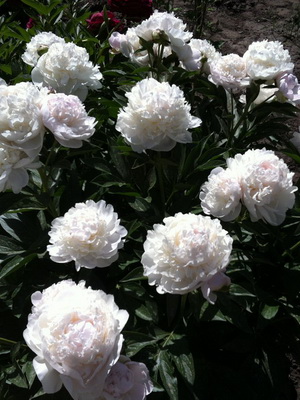
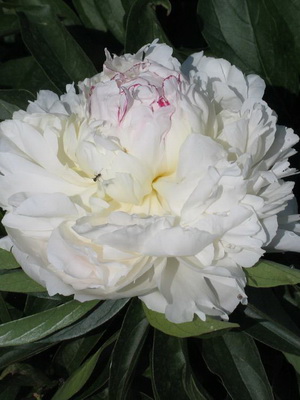
"In memory of academician Tsitsin". The bush is 90 cm high, slightly spreading. Flowers are densely double, pink-shaped, up to 20 cm in diameter, cream-colored with a pink tint. At the base, the petals are yellow. By the end of flowering, the color becomes almost white. The stems are strong, the leaves are large, dark green in color. Suitable for cutting. The variety is one of the best in domestic breeding. This variety of peonies got its name in honor of the Soviet geneticist and breeder N.V. Tsitsin.
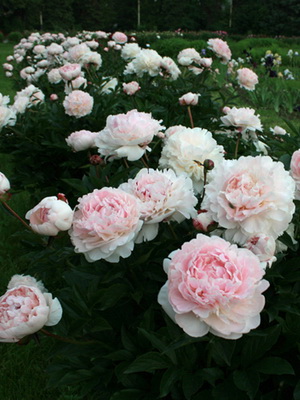
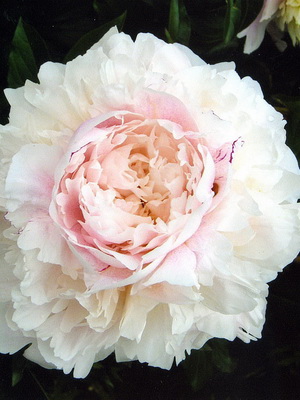
"In memory of Gagarin". The bush is 90 cm high, compact. The buds are double, pink-shaped, the outer petals are wide, flesh-pink in color, the central ones are pale pink with a yellow base. Diameter 18 cm. Some central petals have carmine-colored edging. The flower has a faint pleasant scent. The stems are strong, the leaves are shiny, dark green.
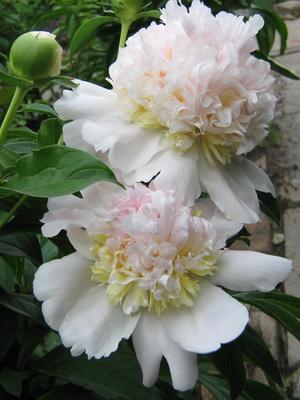

Top Brass. The height of the bush is up to 90 cm. The buds are pale pink, 19 cm in diameter. The middle tier is bright yellow, the lower one is cream, the stems are strong. An unusual flower. The lower petals are very wide. Has a delicate specific aroma.The variety is resistant to adverse weather conditions, diseases and pests. Also resistant to cold and drought. Recommended for growing throughout Russia, except for the Far North.
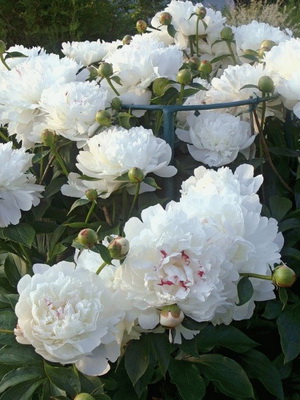
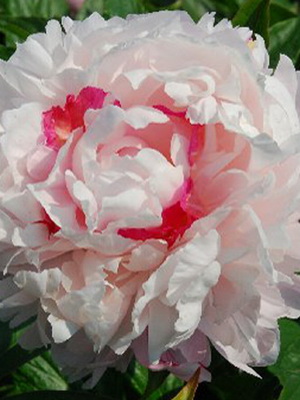
"Spring". A compact bush that reaches a height of 85 cm. The buds are double, crown, dense. Outside, light pink, inside - creamy pink with a yellowish tinge. The flower is quite large, 17 cm in diameter. It has a jasmine scent. Stems are long, slightly drooping; leaves are large, bright green. The variety is not affected by diseases. Universal. Recommended for growing throughout Russia, except for the Far North.


